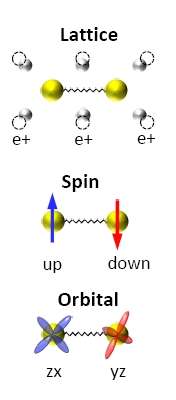May 17, 2011 feature
Iron-pnictide electron orbital pairing promises higher-temperature superconductors

(ĚÇĐÄĘÓƵOrg.com) -- The quest to develop a so-called room-temperature superconductor – one that exhibits lossless electronic transmission – has long fueled both popular and scientific imagination. At the same time, however, ongoing efforts to raise the still-frigid temperatures at which certain materials display superconductivity are making incremental progress. That research – historically based on lattice and/or spin-based interpretations of electron pairing – has now taken a potentially significant step forward thanks to a theoretical view of how electron orbital pairing in a class of materials known as ferropnictides may provide a new road to high transition temperature superconductivity.
The paper, Orbital-Independent Superconducting Gaps in Iron Pnictides, was published in the April 29, 2011 issue of Science. Lead researcher Takahiro Shimojima (affiliated with the University of Tokyo’s Institute for Solid State ĚÇĐÄĘÓƵics, and the Japan Science and Technology Agency’s Core Research for Evolutional Science and Technology) notes that while high transition temperature superconductivity of up to 55K (-218C) in ferropnictides was first observed in 2008, this behavior is not predicted from standard electron pairing based on lattice vibrations. Therefore, says Shimojima, an alternate explanation was needed.
(Ferropnictides – also known as Fe-pnictides and iron pnictides – are compounds classified as members of the so-called nitrogen group, a periodic table group that includes nitrogen, phosphorus, arsenic, antimony, bismuth, and ununpentium – elements with five electrons in their outermost shell. Pnictides are binary compounds of this group. The new class of superconductors Shimojima and his team investigated has conducting layers of iron and arsenic.)
Shimojima and his team focused on what is know as the superconducting gap magnitude – the strength of Cooper pair electron pairing – in various electron orbitals. Using laser-ARPES (laser angle-resolved photoemission spectroscopy), the team determined that electron orbitals, not spin, account for ferropnictide superconductivity. They therefore concluded that electron orbitals – specifically, orbital fluctuations, interorbital pairing induced by magnetism, or a combination of the two – are a third way in which electrons form Cooper pairs.
What prompted the team to consider orbital pairing as a novel binding mechanism in HT superconductivity? “An important insight was Fermi surface orbital polarization in the anti-ferromagnetic metal phase of parent compound BaFe2As2 observed by laser-ARPES,” notes Shimojima. “It was surprising for us that its ground state is realized through orbital-dependent electronic reconstruction. We also found that this result indirectly supported the orbital ordering proposed by theoretical research. We then became curious about the effect of the orbital degrees of freedom on the material’s superconductivity.”
Laser-ARPES was the key tool in the team’s discovery. “One very important technique we developed was the variable laser polarization for examining orbital characteristics,” says Shimojima. “We also achieved high-energy resolution and bulk sensitivity in order to capture high quality data about the superconducting gaps. As a result, we were able to separate the two peak structure in the (Ba,K)Fe2As2 spectrum, which previously makes difficult to interpret ARPES data.”
Going forward, Shimojima points out, if other materials having several entangled orbitals near Fermi level are discovered, it may have the potential to show even higher transition temperature superconductivity due to orbital pairing. “For example,” he adds, “if the transition temperature approaches room temperature, superconducting wires for lossless electronic transportation and storage will quickly be deployed worldwide.”
And so the dream lives on.
More information:
* Orbital-Independent Superconducting Gaps in Iron Pnictides, Published Online 7 April 2011, Published in Science 29 April 2011: Vol. 332 no. 6029 pp. 564-567,
*
*
Copyright 2011 ĚÇĐÄĘÓƵOrg.com.
All rights reserved. This material may not be published, broadcast, rewritten or redistributed in whole or part without the express written permission of ĚÇĐÄĘÓƵOrg.com.




















